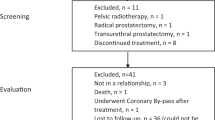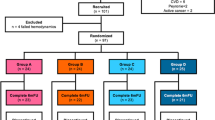Abstract
Objectives:
To study the efficacy of Low intensity Extracorporeal Shockwave Therapy (Li- ESWT) for the treatment of erectile dysfunction (ED) in kidney transplanted men.
Methods:
Twenty men (mean age = 53.7 years) were selected. This was a double-blinded, prospective, randomized, sham-controlled trial. The ESWT protocol was based in a 2 treatment sessions per week for 3 weeks. The sham treatment was performed using the same device replacing the effective probe for one that emits zero energy. Baseline and follow-up assessment was performed with International Index of Erectile Function Questionnaire (IIEF) score and Erection Hardness Score (EHS) after 1, 4 and 12 months. Penile Doppler was performed before and after treatment.
Results:
A total of 20 patients were recruited, 10 patients in each group. Baseline scores were similar. The mean EHS in after 1 month were 2.5 ± 0.85 (Li-EWST) and 2.4 ± 0.7 (Sham therapy), p = 0.724 . After 4 months it was 2.4 ± 0.7 and 2.6 ± 0.84, p = 0,0004 (between the moments) . The baseline IIEF score was 14.9 ± 3(Sham Theraphy) and 10.9 ± 5.1 (Li-EWST). The mean IIEF score after 1 month was 15.6 ± 6.1 (Li-EWST) and 16.6 ± 5.4 (Sham therapy). The mean IIEF score after 4 months was 17.2 ± 5.7 (Li-EWST) and 16.5 ± 5 (Sham therapy), p < 0.0001 (between the moments). IIEF score improvement was higher than 5 in 70% (ranged from 0-10) and in 10% (ranged from 1-14) in Li-ESWT and Sham groups, respectively. The mean change in IIEF score after 12 months was 4.8 in Li-ESWT group .Penile Doppler parameters were similar between groups and did not present improvements.
Conclusions:
Li-ESWT is a treatment with clinical efficacy. Despite evidences suggesting neoagiogenesis, our short protocol had no impact in penile Doppler parameters.
This is a preview of subscription content, access via your institution
Access options
Subscribe to this journal
Receive 8 print issues and online access
$259.00 per year
only $32.38 per issue
Buy this article
- Purchase on Springer Link
- Instant access to full article PDF
Prices may be subject to local taxes which are calculated during checkout






Similar content being viewed by others
References
Feldman HA, Goldstein I, Hatzichristou DG, Krane RJ, McKinlay JB. Impotence and its medical and psychosocial correlates: results of the Massachusetts male aging study. J Urol. 1994;151:54–61.
Althof SE. Quality of life and erectile dysfunction. Urology. 2002;59:803–10.
El-Assmy A, El-Bahnasawy MS, Dawood A, AboBieh E, Ali-El Dein B, El-Dein AB, et al. Vasculogenic erectile dysfunction in renal transplant recipients--assessment of potential risk factors. Scand J Urol Nephrol. 2004;38:511–6.
Jensen J, Lendorf A, Stimpel H, Frost J, Ibsen H, Rosenkilde P. The prevalence and etiology of impotence in 101 male hypertensive outpatients. Am J Hypertens. 1999;12:271–5.
Shamloul R, Ghanem H. Erectile dysfunction. Lancet. 2013;381:153–65.
Malavaud B, Rostaing L, Rischmann P, Sarramon JP, Durand D. High prevalence of erectile dysfunction after renal transplantation. Transplantation. 2000;69:2121–4.
Toorians AW, Janssen E, Laan E, Gooren LJ, Giltay EJ, Oe PL, et al. Chronic renal failure and sexual functioning: clinical status versus objectively assessed sexual response. Nephrol, Dial, Transplant: Off Publ Eur Dial Transplant Assoc - Eur Ren Assoc. 1997;12:2654–63.
Eardley I, Donatucci C, Corbin J, El-Meliegy A, Hatzimouratidis K, McVary K, et al. Pharmacotherapy for erectile dysfunction. J Sex Med. 2010;7(1 Pt 2):524–40.
Aversa A, Bruzziches R, Vitale C, Marazzi G, Francomano D, Barbaro G, et al. Chronic sildenafil in men with diabetes and erectile dysfunction. Expert Opin Drug Metab Toxicol. 2007;3:451–64.
Porst H, Rajfer J, Casabe A, Feldman R, Ralph D, Vieiralves LF, et al. Long-term safety and efficacy of tadalafil 5 mg dosed once daily in men with erectile dysfunction. J Sex Med. 2008;5:2160–9.
Vardi Y, Appel B, Ofer Y, Greunwald I, Dayan L, Jacob G. Effect of chronic sildenafil treatment on penile endothelial function: a randomized, double-blind, placebo controlled study. J Urol. 2009;182:2850–5.
Aicher A, Heeschen C, Sasaki K, Urbich C, Zeiher AM, Dimmeler S. Low-energy shock wave for enhancing recruitment of endothelial progenitor cells: a new modality to increase efficacy of cell therapy in chronic hind limb ischemia. Circulation. 2006;114:2823–30.
Young Academic Urologists Men’s Health Group. Fode M, Hatzichristodoulou G, Serefoglu EC, Verze P, Albersen M. Low-intensity shockwave therapy for erectile dysfunction: is the evidence strong enough. Nat Rev Urol. 2017;14:593–606.
Gotte G, Amelio E, Russo S, Marlinghaus E, Musci G, Suzuki H. Short-time non-enzymatic nitric oxide synthesis from L-arginine and hydrogen peroxide induced by shock waves treatment. FEBS Lett. 2002;520:153–5.
Eardley I. Can an erectogenic pharmacotherapy regimen after radical prostatectomy improve postoperative erectile function? Nat Clin Pract Urol. 2006;3:72–73.
Gonzales AI, Sties SW, Wittkopf PG, Mara LS, Ulbrich AZ, Cardoso FL, et al. Validation of the International Index of Erectile Function (IIFE) for use in Brazil. Arq Bras Cardiol. 2013;101:176–82.
Cappelleri JC, Rosen RC, Smith MD, Mishra A, Osterloh IH. Diagnostic evaluation of the erectile function domain of the international index of erectile function. Urology. 1999;54:346–51.
Mulhall JP, Goldstein I, Bushmakin AG, Cappelleri JC, Hvidsten K. Validation of the erection hardness score. J Sex Med. 2007;4:1626–34.
Vardi Y, Appel B, Jacob G, Massarwi O, Gruenwald I. Can low-intensity extracorporeal shockwave therapy improve erectile function? A 6-month follow-up pilot study in patients with organic erectile dysfunction. Eur Urol. 2010;58:243–8.
Wang CJ, Wang FS, Yang KD, Weng LH, Hsu CC, Huang CS, et al. Shock wave therapy induces neovascularization at the tendon-bone junction. A study in rabbits. J Orthop Res: Off Publ Orthop Res Soc. 2003;21:984–9.
Kovanecz I, Nolazco G, Ferrini MG, Toblli JE, Heydarkhan S, Vernet D, et al. Early onset of fibrosis within the arterial media in a rat model of type 2 diabetes mellitus with erectile dysfunction. BJU Int. 2009;103:1396–404.
Petschnik AE, Fell B, Kruse C, Danner S. The role of alpha-smooth muscle actin in myogenic differentiation of human glandular stem cells and their potential for smooth muscle cell replacement therapies. Expert Opin Biol Ther. 2010;10:853–61.
Liu J, Zhou F, Li GY, Wang L, Li HX, Bai GY, et al. Evaluation of the effect of different doses of low energy shock wave therapy on the erectile function of streptozotocin (STZ)-induced diabetic rats. Int J Mol Sci. 2013;14:10661–73.
Vardi Y, Appel B, Kilchevsky A, Gruenwald I. Does low intensity extracorporeal shock wave therapy have a physiological effect on erectile function? Short-term results of a randomized, double-blind, sham controlled study. J Urol. 2012;187:1769–75.
Lu Z, Lin G, Reed-Maldonado A, Wang C, Lee YC, Lue TF. Low-intensity extracorporeal shock wave treatment improves erectile function: a systematic review and meta-analysis. Eur Urol. 2017;71:223–33.
Gruenwald I, Appel B, Vardi Y. Low-intensity extracorporeal shock wave therapy--a novel effective treatment for erectile dysfunction in severe ED patients who respond poorly to PDE5 inhibitor therapy. J Sex Med. 2012;9:259–64.
Olsen AB, Persiani M, Boie S, Hanna M, Lund L. Can low-intensity extracorporeal shockwave therapy improve erectile dysfunction? A prospective, randomized, double-blind, placebo-controlled study. Scand J Urol. 2015;49:329–33.
Kalyvianakis D, Memmos E, Mykoniatis I, Kapoteli P, Memmos D, Hatzichristou D. Low-intensity shockwave therapy for erectile dysfunction: a randomized clinical trial comparing 2 treatment protocols and the impact of repeating treatment. J Sex Med. 2018;15:334–45.
Author's contribution
KGRY: manuscript writing and data collection; FC: data management; JC: project management and data analysis; RL: data collection and treatment application; PCF: data collection; ACP: manuscript revision; MS: project management and data analysis; WCN: project management; and IMA: manuscript editing and project design.
Author information
Authors and Affiliations
Corresponding author
Ethics declarations
Conflict of interest
The authors declare that they have no conflict of interest.
Informed consent
Informed consent was obtained from all individual participants included in the study.
Ethical approval
All procedures performed in studies involving human participants were in accordance with the ethical standards of the institutional and/or national research committee, and the 1964 Helsinki declaration and its later amendments or comparable ethical standards.
Rights and permissions
About this article
Cite this article
Yamaçake, K.G.R., Carneiro, F., Cury, J. et al. Low-intensity shockwave therapy for erectile dysfunction in kidney transplant recipients. A prospective, randomized, double blinded, sham-controlled study with evaluation by penile Doppler ultrasonography. Int J Impot Res 31, 195–203 (2019). https://doi.org/10.1038/s41443-018-0062-2
Received:
Revised:
Accepted:
Published:
Issue Date:
DOI: https://doi.org/10.1038/s41443-018-0062-2
This article is cited by
-
A fragility index analysis of clinical trials evaluating low-intensity extracorporeal shockwave therapy for erectile dysfunction
International Journal of Impotence Research (2023)
-
Conservative Non-surgical Options for Erectile Dysfunction
Current Urology Reports (2023)
-
Effects of renal transplantation on erectile dysfunction: a systematic review and meta-analysis
International Journal of Impotence Research (2022)
-
Li-Eswt improves hemodynamic parameters thus suggesting neoangiogenesis in patients with vascular erectile dysfunction
International Journal of Impotence Research (2022)
-
Review and Clinical Progress of Allograft Penis Transplantation
Indian Journal of Surgery (2022)



